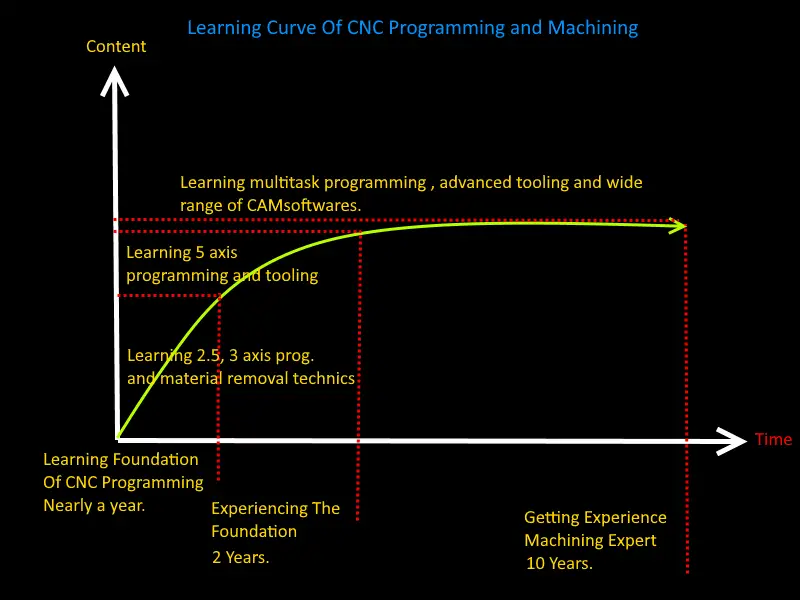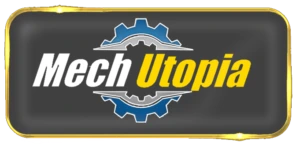
Introduction
Simple CNC programming techniques are quite easy to learn, however, it takes time, so in a short time frame learning outcomes can be limited and not very satisfying. With enough time you need to get your hands dirty and spend enough time with highly complex parts and CAD/CAM systems. Also, CNC programmers must have some machining Industry related work culture and experience.
Is CNC Programming Hard To Learn?
With a foundation in technical drawing, basic math, and manual machining, beginners can swiftly learn G-code and 2D-CAM programming in a week. However, mastering advanced 3 & 5 axis CAD-CAM programming demands a dedicated 1 to 3 years.When we look at them all together it seems like a lot to learn, good news; today there are so many online sources for learning a new profession. Another reality is that taught programmers are respected today by the industry.
Everyone has a unique set of comprehension and learning abilities. Every profession also has best practices, strategies, and the most efficient way to do things. These factors can have a direct impact on your CNC programming learning progress.
What Are The Challenges Of CNC Programming?
- Understanding geometrical shapes:
– When creating CNC programs, you must consider the geometry of the part that will be machined. Rods, squares, rectangles, circular bars, conics, holes, and pockets, to name a few. In CNC programming, they are the most popular geometrical shapes and shape-related machining operations. - Preciseness and measurement:
– In this career, it is critical to understand the units and the significance of the dimensions. For example, you should be able to understand the differences between 0.001mm and 10mm on a dimensional and conceptual level. If you’re wondering, human hair can be as thin as 0.001mm, whereas a KitKat can be as thick as 10mm. - Understanding Engineering real-world materials:
– Firstly you can get more detailed information about the engineering materials, especially for metals in this link. When programming a component for CNC machining, you must have a thorough understanding of the tools and their feeds and speeds. These rates are typically offered by tool manufacturers, however, they are overly optimistic; in real-world applications, engineering materials respond differently depending on workholding style, machining technique, and cooling choice. Stainless Steel, Mild Steel, Aluminium Alloys, Brass, Copper, and Plastics all those materials have different cutting feeds and speeds. As a result, you will select the values that provide optimal cutting tool efficiency in order to keep costs low and machine speed high. Your manager will evaluate you based on your values. - Mechanical part drawings and blueprints:
– As CNC programmers, we are always working with mechanical designs, which provide us with detailed information about components. We can communicate in this manner without having to meet in person. To avoid misunderstandings, you will use ISO standard drawing conventions. These blueprints can be extremely simple or quite sophisticated. This will be another significant challenge for new CNC programmers. - Wide and varied CAD-CAM Software:
– We shall look at the simplest programming methods in the future. Please continue to be patient. CAD-CAM software is one of the simplest ways to create complex CNC programs. The problem is that there are tens of CAD-CAM software in the CNC machining trade. They’re all incredibly smart and easy to use. However, you may need to master more than one CAM software, as well as 3D solid modeling to produce Parasolid geometries for programming.
So, in order to make your CNC learning journey easier, you must have a solid strategy that provides you with a solid foundation. Let’s have a look at CNC programming approaches. Programming methods vary, but we usually use one of them today, which we shall discuss shortly. You can also read this article, which provides a detailed explanation of CNC programming methods.

CNC programming will be simpler than ever these days. We were writing CNC programs on massive computers over 50 years ago. Those computers were punching a lot of holes in something resembling a cassette tape, and CNC machines were reading instructions from those cassettes.
In CNC workshops nowadays, we have the most powerful workstations that can process hundreds of megabytes of solid models in a single session. In addition, we can examine our designed tool path in 3D on the screen. This is referred to as solid-cutting verification. Before machining, you create a program and view the results. Isn’t that incredible right? Let’s take a look at each programming approach one by one.
A Full Comparison Of CNC Programming Approaches With Pros And Cons.
Which Programming Approach Is Better For Today’s CNC Programmers And Machinists?
As shown in the table above, those programming techniques have inherited one another. For example, we invented G-Code programming as the highest level of programming first, but CNC engineers discovered a way to make it more convenient with the canned cycle approach.
Finally, they established 3D modeling and complicated surface machining toolpath algorithms to generate extremely complex G-Codes and Canned Cycles, leading us to a new level of convenience. As you can see, it is becoming easier over time.
CNC Programming Basics
For a beginner who has just started learning CNC programming, the best approach would be to learn pure G-Code and M-Code programming by practice without using a real CNC machine. (A short information; G-Code programming also includes M codes, M stands for “Miscellaneous”. M codes are used to switch on or off CNC machine features such as the cooling liquid pump, spindle, and alarms. G code is used to control functions such as feed rates, setting fast or slow motion mode, and so on).
Another helpful thing to do as a beginner is to learn how to use manual milling and center lathe machines before learning how to use CNC equipment. Consider this: all CNC machines are descended from milling machines and center lathe machines. Even Galileo worked as a turner at one point in his life by producing clock parts. You will have a strong understanding of 3-axis motion by using these manual machines (X, Y, Z). You will also learn a lot about engineering materials and machine operations ( like; contouring, pocketing, and drilling holes ).
When you have a thorough understanding of machining and 3-axis motion technologies, you can apply what you’ve learned with G-Codes. G-code programming is a foundational skill that all CNC machinists must acquire. Because, even if we utilize CAD-CAM software, at some point, we must change post-processed CNC programs (G-Code ones) as problems arise. Learning G-Codes is also the most straightforward stage for newbies.
When you’re comfortable with it, you may begin to employ Canned Cycles in your program to create a shorter version of it. As I previously stated, complex programming approaches are not required for simple operations. G-codes are useful for basic facing operations or drilling a couple of holes.
Today’s machine shops rely heavily on CAD-CAM technologies, with some conversational programming thrown in for good measure.

Because of their ease of use for complex tasks, CAD-CAM systems have taken over CNC programming in the majority of workplaces. These systems are powered by a variety of features, such as the ability to generate multiple programs for different brand machines, feed and speed calculations, tool management, work holding management, and so on.
This cutting-edge technology enables us to create complicated surfaces featured in automobiles and aerospace components. To be honest, I can’t imagine how CAD-CAM systems and CNC machines got together to make our world more developed.
It’s getting better. New developments in AI technology are attempting to make CAD-CAM programming more efficient. This is just another problem that engineers and programmers will experience in the near future. To make things easier, these techniques will also be used with conversational programming.
Where To Learn CNC Programming?
The learning environment influences whether you learn CNC programming easily or with frustration. Learning through doing is the best way to learn CNC programming and machining. As you may expect, colleges and institutes offer CNC programming classes.
They are, however, more theoretical and less applied. This opens up a new avenue of learning for those of us who are apprentices. As a CNC machining trainee, you begin learning from the ground up. You will also be able to obtain more industry-related positions, which will provide you with additional value that schools cannot provide.
Schools, on the other hand, provide certifications that you can use to demonstrate your learning experience when looking for a job. As you may expect, this method is more official and not as enjoyable as being an apprentice, but it has some advantages.
In last years the advance of AI (Artificial Intelligence) CNC programming just got easier to learn. Because this AI system abstracts complex software usage from CNC programmers.
Summary
In conclusion, we have discussed how CNC programming may be both difficult and simple. As you can see, there are numerous variables that might determine whether CNC programming is easy or difficult. It is directly affected by your attitude, capacity to operate under pressure, and technical skills. Being a CNC machinist and programmer, in my opinion, is simple if you follow the logical steps we discussed. It is a rewarding job that is well worth learning.

